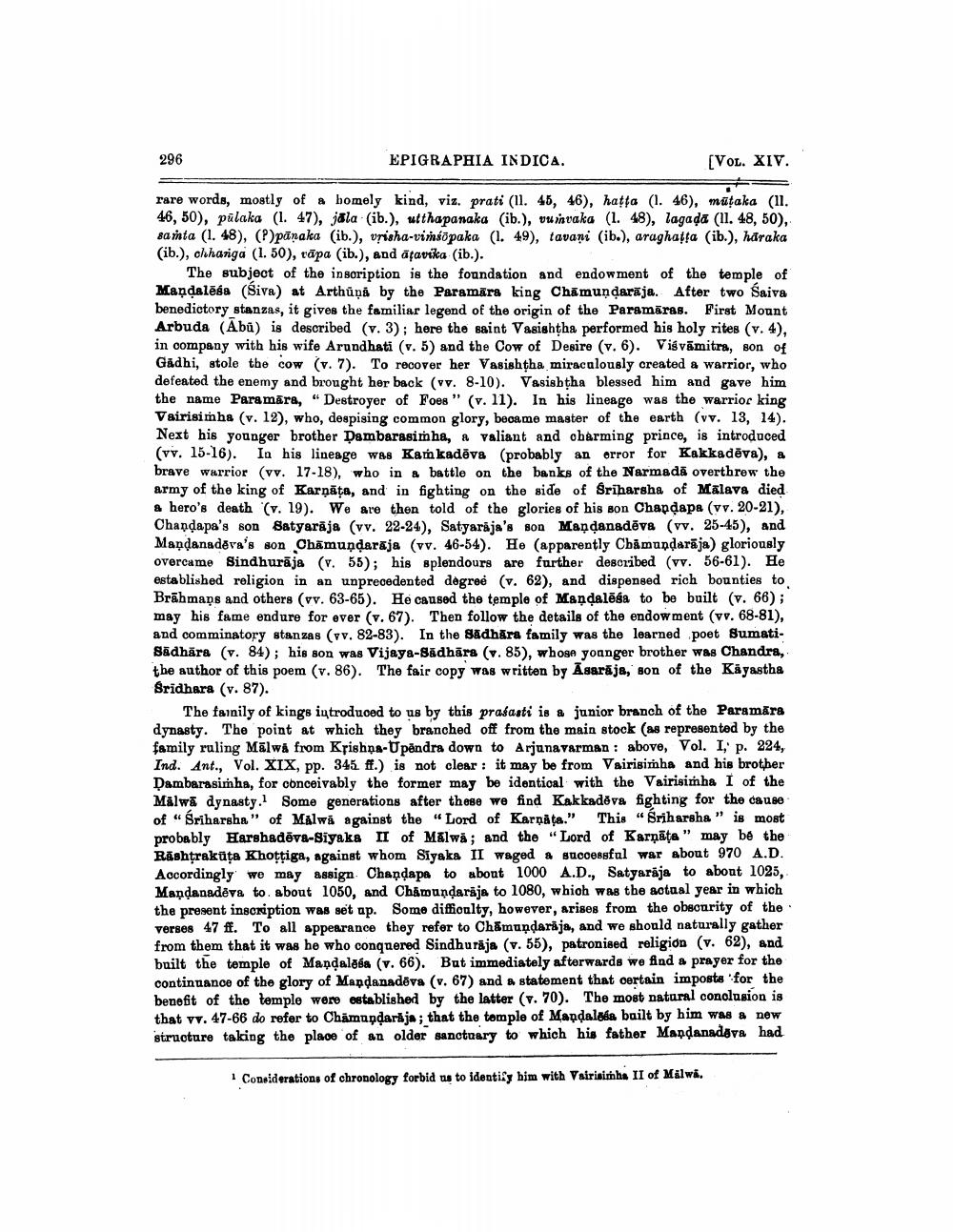________________
296
EPIGRAPHIA INDICA.
[VOL. XIV.
rare words, mostly of a homoly kind, viz. prati (11. 45, 46), hatta (1. 46). mütaka (11. 46, 50), pūlaka (1. 47), jala (ib.), utthapanaka (ib.), vuivaka (1. 48), lagada (Il. 48, 50), santa (1. 48), (pānaka (ib.), vrisha-vinsõpaka (I. 49), tavani (ib.), araghafta (ib.), haraka (ib.), chhariga (1. 50), rāpa (ib.), and afavika (ib.).
The subject of the inscription is the foundation and endowment of the temple of Mandalēga (Śiva) at Arthūņå by the Paramāra king Chāmundarāja. After two Saiva benedictory stanzas, it gives the familiar legend of the origin of the Paramāras. First Mount Arbuda (Abu) is described (v. 3); here the saint Vasishtha performed his holy rites (v.4). in company with his wife Arundhati (v. 5) and the Cow of Desire (v. 6). Visvāmitra, son of Gadhi, stole the cow (v.7). To recover her Vasishtha miraculously created a warrior, who defeated the enemy and brought her back (vv. 8-10). Vasishtha blessed him and gave him the name Paramāra, " Destroyer of Foes" (v. 11). In his lineage was the warrior king Vairisimha (v. 12), who, despising common glory, became master of the earth (vv. 13, 14). Next his younger brother Dambarasimha, a valiant and charming prince, is introduced (vv. 15-16). In his lineage was Kakadēva (probably an error for Kakkadēva), a brave warrior (vv. 17-18), who in a battle on the banks of the Narmadā overthrew the army of the king of Karnāta, and in fighting on the side of Sriharsha of Mālava died a hero's death (v. 19). We are then told of the glories of his son Chapdapa (vv. 20-21), Chandapa's son Satyarāja (vv. 22-24), Satyaraja's son Mandanadēva (vv. 25-45), and Mandanadeva's son Chamundarāja (vv. 46-54). He (apparently Chămundarāja) gloriously overcame Sindhurāja (v. 55); his splendours are further described (vv. 56-61). He established religion in an unprecedented degree (v. 62), and dispensed rich bounties to Brāhmaṇs and others (vv. 63-65). He caused the temple of Mandalēga to be built (v. 66); may his fame endure for ever (v. 67). Then follow the details of the endowment (vv. 68-81), and comminatory stanzas (vv. 82-83). In the sidhāra family was the learned poet Sumatisādhāra (v. 84); his son was Vijaya-Sadhāra (v. 85), whose younger brother was Chandra, the author of this poem (v. 86). The fair copy was written by Agarāja, son of the Kiyastha Sridhara (v. 87).
The fainily of kings introduced to us by this prasasti is a junior branch of the Paramāra dynasty. The point at which they branched off from the main stock (as represented by the family ruling Mālwa from Krishna-Upêndra down to Arjunavarman : above, Vol. I, p. 224, Ind. Ant., Vol. XIX, pp. 345 ff.) is not clear: it may be from Vairisimha and his brother Dambarasimha, for onceivably the former may be identical with the Vairisimha I of the Malwa dynasty. Some generations after these we find Kakkadova fighting for the cause of Sriharsha" of Malwa against the “Lord of Karnata." This “Briharsha " is most probably Harshadēva-Siyaka II of Malwa; and the Lord of Karnāta " may be the Rashtrakuţa Khottiga, against whom Siyaka II waged a successful war about 970 A.D. Accordingly we may assign Chandapa to about 1000 A.D., Satyarāja to about 1025, Mandanadēva to about 1050, and Chamundarāja to 1080, which was the actual year in which the present inscription was set up. Some difficulty, however, arises from the obecurity of the verses 47 ff. To all appearance they refer to Chimaņdaraja, and we should naturally gather from them that it was he who conquered Sindhurāja (v. 55), patronised religion (v. 62), and built the temple of Mandalasa (v. 66). But immediately afterwards we find a prayer for the continuanoe of the glory of Mandanadēva (v. 67) and a statement that certain imposts for the benefit of the temple were established by the latter (v. 70). The most natural conolusion is that vv. 47-66 do refer to Chamundarája; that the tom ple of Mandalasa built by him was a new structure taking the place of an older sanctuary to which his father Mandanadova had
Conoiderations of chronology forbid us to identify him with Vairininha II of Milwa.




